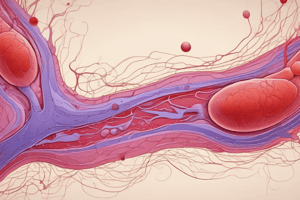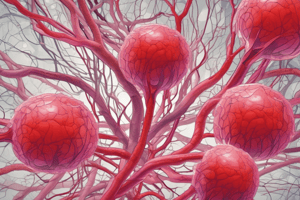Podcast
Questions and Answers
What is the primary function of the platelets in the blood clotting process?
What is the primary function of the platelets in the blood clotting process?
- To form an initial plug to contain the blood (correct)
- To create a mesh to hold the fibrin strands together
- To prevent the formation of fibrin strands
- To solidify the plug formed at the site of injury
What is the purpose of the fibrin strands in the blood clotting process?
What is the purpose of the fibrin strands in the blood clotting process?
- To create a barrier to prevent platelets from reaching the site of injury
- To dissolve the initial plug formed by platelets
- To act as a mesh to hold the platelet plug together solidly (correct)
- To prevent the formation of a blood clot
What is the characteristic of fibrin molecules or proteins?
What is the characteristic of fibrin molecules or proteins?
- They have a natural affinity for platelets
- They are incapable of forming polymers
- They can only be found at the site of injury
- They have a natural affinity for each other (correct)
Why are fibrin molecules not found circulating in the blood?
Why are fibrin molecules not found circulating in the blood?
What is the purpose of the extra piece attached to fibrin in the blood?
What is the purpose of the extra piece attached to fibrin in the blood?
What is the result of the platelets coming together to form an initial plug?
What is the result of the platelets coming together to form an initial plug?
What would happen if fibrin molecules were able to circulate freely in the blood?
What would happen if fibrin molecules were able to circulate freely in the blood?
What is the final result of the blood clotting process?
What is the final result of the blood clotting process?
What would happen if the negative feedback loops in the clotting system did not exist?
What would happen if the negative feedback loops in the clotting system did not exist?
What is the role of thrombin in the clotting system?
What is the role of thrombin in the clotting system?
What is the primary function of plasmin in the clotting system?
What is the primary function of plasmin in the clotting system?
What is the term for a bleeding disorder caused by a defect in the clotting system?
What is the term for a bleeding disorder caused by a defect in the clotting system?
Which factor deficiency is associated with Hemophelia A?
Which factor deficiency is associated with Hemophelia A?
What pathway do the factors associated with Hemophelia target?
What pathway do the factors associated with Hemophelia target?
What is the role of anti-thrombin in the clotting system?
What is the role of anti-thrombin in the clotting system?
What would be the result of a factor XI deficiency?
What would be the result of a factor XI deficiency?
What is the primary function of fibrinogen in the body?
What is the primary function of fibrinogen in the body?
What is the concentration of factor I (fibrinogen) in blood?
What is the concentration of factor I (fibrinogen) in blood?
What triggers the conversion of fibrinogen to fibrin at the site of injury?
What triggers the conversion of fibrinogen to fibrin at the site of injury?
What activates factor X in the extrinsic pathway?
What activates factor X in the extrinsic pathway?
Why is thrombin a more efficient converter of fibrinogen to fibrin than the 'little yellow guys'?
Why is thrombin a more efficient converter of fibrinogen to fibrin than the 'little yellow guys'?
What is the inactive form of thrombin called?
What is the inactive form of thrombin called?
What is the role of the intrinsic pathway in blood coagulation?
What is the role of the intrinsic pathway in blood coagulation?
What is the name of the pathway that involves the clotting cascade starting from XII?
What is the name of the pathway that involves the clotting cascade starting from XII?
What is the function of thrombin in the coagulation cascade?
What is the function of thrombin in the coagulation cascade?
What is the role of XII in the clotting cascade?
What is the role of XII in the clotting cascade?
What is the role of factor XIII in the coagulation cascade?
What is the role of factor XIII in the coagulation cascade?
What is the relationship between X and V in the clotting cascade?
What is the relationship between X and V in the clotting cascade?
What is the difference between the extrinsic and intrinsic pathways?
What is the difference between the extrinsic and intrinsic pathways?
What is the function of tissue factor in the coagulation cascade?
What is the function of tissue factor in the coagulation cascade?
What happens to XI when it is activated?
What happens to XI when it is activated?
What is the role of thrombin in the clotting cascade?
What is the role of thrombin in the clotting cascade?
What is the result of the coagulation cascade?
What is the result of the coagulation cascade?
What is the relationship between the arrows in the clotting cascade diagram?
What is the relationship between the arrows in the clotting cascade diagram?
What is the significance of factor XII in the coagulation cascade?
What is the significance of factor XII in the coagulation cascade?
What is the difference between the green arrow and the white arrows in the diagram?
What is the difference between the green arrow and the white arrows in the diagram?
Flashcards are hidden until you start studying
Study Notes
Blood Vessel Injury and Clotting
- When a blood vessel gets hurt, its walls break open, and cells no longer seal the vessel, which can lead to blood loss.
- The body has a mechanism to contain the blood and prevent excessive loss.
Initial Plug Formation
- Platelets circulating in the body come to the site of injury and form an initial plug to stop the bleeding.
- The platelet plug is not solid enough, and the body needs a second mechanism to solidify it.
Fibrin Strands and Fibrinogen
- Fibrin strands, composed of fibrin sub-units or proteins, act as a mesh to hold the platelet plug together.
- Fibrin molecules have a natural affinity for each other, forming a polymer when brought together.
- Fibrinogen is the precursor to fibrin, but it cannot circulate in the blood because it would form fibrin strands spontaneously.
Fibrinogen Conversion to Fibrin
- When the endothelium is injured, new proteins are exposed or released, which trigger the conversion of fibrinogen to fibrin.
- Thrombin is the enzyme that converts fibrinogen to fibrin.
Thrombin and Clotting Cascade
- Thrombin is activated from an inactive form called prothrombin.
- Thrombin activates other clotting factors, leading to a cascade of reactions that ultimately form a fibrin mesh.
- The clotting cascade is an amplification sequence, with each step increasing the amount of active clotting factors.
Intrinsic and Extrinsic Pathways
- There are two pathways that lead to the formation of fibrin: the intrinsic pathway and the extrinsic pathway.
- The intrinsic pathway is the "workhorse" that does most of the coagulation, while the extrinsic pathway is the "spark" that initiates the process.
- The extrinsic pathway is activated by tissue factor, which is exposed or released when the endothelium is injured.
Thrombin's Role in Clotting
- Thrombin activates factors V, VII, VIII, XI, and XIII, which are necessary for the intrinsic pathway.
- Thrombin also has a positive feedback loop, which can lead to an overproduction of fibrin if left unchecked.
Negative Feedback Loops
- To prevent excessive clotting, there are negative feedback loops that reduce the amount of thrombin and fibrin produced.
- Examples of negative feedback loops include thrombin stimulating the production of anti-thrombin and plasmin, which break down fibrin meshes.
Hemophilia
- If the clotting system doesn't work, it can lead to excessive bleeding, a condition known as hemophilia.
- There are three types of hemophilia: A, B, and C, which are caused by deficiencies in factors VIII, IX, and XI, respectively.
Studying That Suits You
Use AI to generate personalized quizzes and flashcards to suit your learning preferences.




